

We
at TCH decided to harvest some
reflections on the growing season past from Gardeners who have
taken on special jobs and projects, so we might see -- as we see
in the intricacies concealed by the illusion of splendid
simplicity in the assembled harvest of squashes and pumpkins --
the marvellous way we make the Garden grow.
Chester,
Reva and Jackie

The
first important work of the garden started in January when the
Planting Committee, under the leadership of Ken Holmes and Mary
Austin, met and inventoried the seeds and then placed orders for
new seeds for the year. The Greenhouse was the next to
phase in, and was in full operation by mid-February under the new
leadership of Mary Ann Brauer. Ben Klagenberg and his
construction crew had a number of projects started, including two
new cold frames, new raspberry trellises and watering system, a
raised carrot bed, and getting Big Red on its feet.
The
weather gods smiled on us during the first three months and we
were able to get a good start. My hope was to have all of
the beds planted by the Summer Solstice, June 21st, when the sun
exposure is at its maximum. We didn't achieve this goal but
we didn't miss by very much. We had a summer cold period
that slowed down both the garden and greenhouse production.
After a good start with the Taxi tomatoes, many of the others
have languished and not turned. All during this period, we
have enjoyed excellent root crops, good sugar snap peas,
lettuces, broccoli, cauliflower, and cabbage. Our usually
wonderful raspberries were a disappointment and the strawberries
just marginal.
As
the summer has moved into fall and we have had a lovely period of
good weather, most of the crops have recovered and are doing
well; the cucumbers have been overpowering and the herbs
first-rate.
This
year we had three new experiments underway: the use of kelp as a
soil amendment, the use of red plastic for tomato cover, and the
use of pomace (grape skin and vineyard leavings) as an additive.
Our results were not conclusive; none were negative, so we will
continue with them into next year to see if long-term use will be
a positive. The use of raised beds has been a definite
success.
What
are we going to do differently next year? We feel that our
mode of operation is sound; what we hope is to do everything in
the process a little bit better. This includes what seeds we
order, our greenhouse schedule and germination success, when and
how we bring beds into service, our watering practices, more
raised beds, and many prayers and offerings to the weather gods.
It
is always a good year when you have the opportunity to work on
something as productive as a garden with people you enjoy and
with whom you find a common bond. I hope you will all find
in your hearts to join again next season.
Tom
Warnock, Co-Chair, Steering Committee

We
end the year with a modest cash balance of approximately $3500,
of which about $650 is reserved for the Doris Buck trellis. As
the very new treasurer for Posh Squash, I am really impressed by
how much is accomplished with a very small amount of money.
Our total budget is well under $10,000 annually, with water being our largest single expenditure item. Obviously, operating on a tight budget means that maintaining some reserves is essential, as replacement of any major equipment would strain the annual budget.
I
haven't begun to calculate the value of the produce we all enjoy
from the garden, but it must be in the hundreds of thousands of
dollars each year.
How
do we do it? With 125 members, each volunteering an average
of three hours per week for six months of the year, we have a
total of 9000 mostly women-hours (some men) providing the
know-how and labor that leverages such a small cash investment
into such a bountiful harvest.
Wink
Franklin, Treasurer
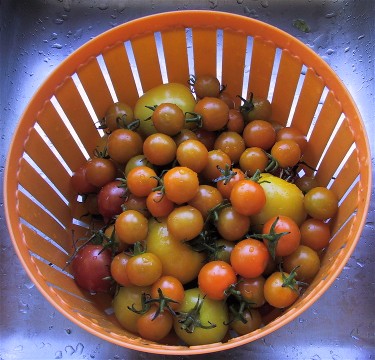
I looked down at my dinner plate the other night and viewed it with a different perspective and a new appreciation. A salad with lettuces of various colors and textures mixed with beautiful sweet gold tomatoes and crunchy chunks of lemon cucumber. Beside it, a steaming serving of mixed zucchini and other summer squashes, and a portion of roasted chicken seasoned with the herbs of our garden. The hands of my fellow gardeners had nurtured most all of it. People I know and had worked beside in our garden all had had a hand in it.
From
the team that prepares the compost, to the tillers of the soil,
to the planters of the seeds, to the waterers and weeders who
spent long hours to make sure that seeds and water and soil,
mixed just right with the sun's energy, would yield the harvest
we're all able to enjoy near season's end. I've even grown
to better appreciate the field workers and farmers that produce
so much of our store-bought food.
The Posh Squash has had a mostly very successful year. We've had some disappointments and one or two downright failures, but that seems always to be the case. In the seven years that I've been working in the garden I can't remember a year where something didn't fail to live up to our always-high expectations. I recall only one year when tomatoes ripened in sufficient numbers to make sauces enough for a couple of meals.
So,
considering the wide variety of crops we are trying to grow and
the natural variations in weather and insect populations that
happen each year, we should expect to have some poorer crops here
and there. This year, thanks to MA's greenhouse crew, we
will have quite a few beds of vegetables growing into early
winter. They've already been put into the ground and the mild
autumn has given them a good start -- peas, green beans, chard,
kale, lettuces and kohlrabi, to name a few. Enjoy the rest
of this year's harvest. Your hands and many others have
made it possible.
Ken
Holmes, Planting Coordinator
Chester
Case and Debbie Hoyt, resident compost nuts, have been fretting
about the relatively low thermometer readings from their compost
bins, heaps and piles. Why not hotter stuff? Not enough nitrogen,
too much moisture, insufficient tossing and tumbling? Surely, it
can be hotter, thus sterilizing seeds, killing germs, and the
like. Then the thermometer broke. Chester bought a new one.
Suddenly, the compost is really cooking! Temperatures risen!
There must be a moral to this story.
This
has been a productive year for Posh Squash compost. Twelve
bins have been at work, plus three wire-cage piles and several
heaps. The shredder has been howling and grinding away at viney
and stalky stuff, which is now going into the piles along with
horse manure from the Equestrian Center. Coffee grounds and
eggshells are coming to us from Starbucks and Twofish Bakery.
Gardeners bring their kitchen trimmings. Spent plants decompose
to enrich the next plantings. What an economy, all simply built
into the scheme of things, wanting only an assist to fulfill
itself.
What
grows in the Garden stays in the Garden (except what goes onto
Gardeners' tables). When the burn pile is down to ash, it will go
into the compost. The Compost Works, if I can be extravagant, is
the digestive system of the Garden, and a pungent metaphor for
the sustainability of self-renewing systems. Working with
compost, witnessing the beneficial metamorphosis of garbage into
garden gold, you feel like you are working with the life forces,
you and the microbes, worms, insects, fungus and bacteria... You
even feel expansive and magnanimous as the raven, raccoon and
skunk poke and plunder the piles. There's plenty for all in an
ecosystem aspiring to renewability.
Chester
Case, Composter

The
primary working element in "Projects and Maintenance"
is the construction crew. It is made up of 14 members from the
overall garden membership. Over the past three years, they have
built the garden shed, constructed the raised flower beds,
extended the compost from eight to twelve bins, built the
greenhouse, and many other projects. Small but essential
projects come up all the time, like repairing a fence or gate,
fixing a leaking faucet, and the like.
In
2003 the principal projects were the raspberry support and
the irrigation system. We added two more cold frames for the
green house. Relocated and built a new hose rack. Built four more
raised beds from recycled lumber. Questions have been posed
regarding the value of raised beds. Why are we doing it? The best
answer I can give is: It saves water -- less surface area exposed
to the elements compared to the growing area. It reduces erosion
-- the garden is on a hillside and the soil keeps moving
downhill; with the raised beds, the edges are contained and
erosion is reduced. It enhances the ability to develop an
improved soil mix. It reduces the effort to weed. It allows for a
greater concentration of planting. We use the full width of the
bed. We plan to install more raised beds wherever it makes good
sense.
During
the past year we overhauled the transmission on Big Red, the
rototiller. So far it looks like we will get our money's worth
out of the effort. Also, we overhauled the shredder, serviced the
weedwhackers and the small tillers, the two mantises. On the
horizon is the construction of the memorial trellis, a new fence
on the south end and a new gate for the entrance.
Ben
Klagenberg, Projects and Maintenance Team Leader

This was my first year as Greenhouse manager so it's hard for me to compare this year to past ones. What has seemed to me the greatest success and most pleasant surprise has been the quality, enthusiasm and dedication of my crew. I call them my elves for all the magical, miracle things they do. They readily learned their skills and went right to work cranking out the "babies." I sure hope all you elves come back next year and work your magic again.
Our
main problem child was the squash. We had that extended
rainy cold spell in April which they hated and would not come out
and play. We had to start over with the zucchini and some of the
winter squashes when it was warmer. I bought a heat pad for next
year to hopefully remedy this kind of problem. What I would
like to work on next year is honing our watering skills.
MA
Brauer, Greenhouse Coordinator
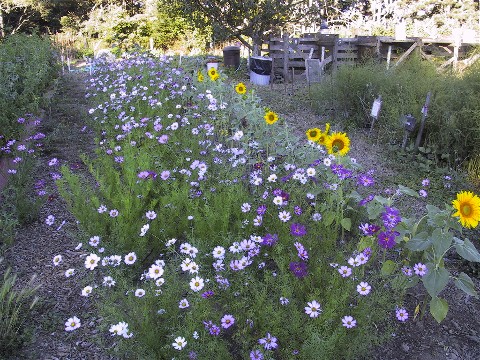
The
definition of a habitat garden, according to Kate Frey of the
organic gardens at the Fetzer Vineyard, is a place in
"constant activity... beneficial to man, beast and nature,
flowers appealing to bird, man and insects -- such is a habitat
garden. No one should be without one."
Dill,
chamomile, basil, rosemary, pineapple sage, sunflowers, purple
millet, marigolds, cilantro... many plants serve our habitat
garden. This year, for instance, we observed aphids
attracted to the garlic chives and dahlias instead of to the
destruction of other edible plants. Hummingbirds and bees
continued to feed and pollinate. Man, bird, insect,
nature... all contributing to the well-being of our garden.
My
guiding principle for the herb beds in their second year has been
to maintain the abundant growth of our collection. And, as the
memorial to Doris Buck has become a reality, my goal has been to
reorganize the main flower beds to provide a place of beauty and
reflection within which the arbor and bench will reside. As
I plan for the next growing season, my hope is to organize the
care and, most importantly, the proper watering of herbs and
flowers as separate from the main vegetable garden.
The
Posh Squash…. a fine habitat garden, indeed.
Dianne
Rasmussen, Herbs and Flowers Leader
It
has been my pleasure, for the past year, to maintain the GIANT
Posh Squash Scrapbook (begun in 1975), and to begin a new
scrapbook for the decade 2000. According to the Society of
American Archivists, archives are considered the non-current
records of individuals and groups that contain information of
enduring value -- in other words, the records of everyday
activity that goes on in our community garden. The album for the
years 2000-2003 is mainly a collection of fairly current
photographs and newsletters. I am in need of and would be happy
to receive and include all manner of documentation for these more
recent years. Archives benefit everyone; they are a way of
supporting our gardening community's collective memory.
Maria
Bardini-Perkins, Archivist
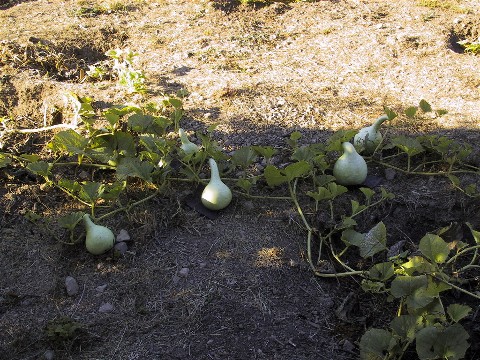
This
year, Chester Case (editor-in-chief), Reva Basch (copy editor and
webmaster) and Jackie Gardener (layout and publication), exceeded
all previous records with seven really pretty good issues. During
the growing season, almost monthly, The Compost Heap
has brought reports from the Steering Committee, news and
announcement, features, recipes, photos and haiku to the
Gardeners. Contributing Gardeners have varied the fare with
columns, reviews and more recipes. But, you say, this must have
cost a bundle. Not so; actual cash cost has been amazingly low --
just paper and ink, really. Fortunately for TCH,
Jackie donates the services of her hardy computer and printer.
By
the way, we didn’t invent the name The Compost
Heap, as appropriate as it is. Since its beginning,
the Posh Squash has had intermittent newsletters, all with that
title.
Now,
TCH dives under its mulch and retires
for the winter. However, keep your eye on our splendid website, www.jereva.com/PoshSquash, for news and announcements.
See you in print next February.
Chester
Case, Editor
The
Garden website, or dot.Compost Heap,
has just completed its second season. It includes all the
articles that appear in the paper edition of the newsletter, and
more – features we didn't have space for in print, more
complete versions of articles, additional information, and
photographs galore. Following each year's organizational meeting,
we post that season's Posh Squash roster along with other timely
(and timeless) information about procedures and who's in charge
of what. If you misplace your paper copy, remember: you can look
it up on our website at www.jereva.com/PoshSquash.
If
you're searching for an article from a particular issue of The
Compost Heap from 2002 to the present, you'll find
it on the website, too. You can browse issue by issue, or click
to the article index and look up the specific item you want.
Eventually, I'd like to add links to other gardening-related
sites elsewhere on the web. If you have any favorites, or other
suggestions for the website, please do let me know. You can reach
me at reva@well.com.
Speaking
of email, the Steering Committee has been trying to use that
medium more regularly this season to communicate time-critical
information to Gardeners, including work parties as well as other
developments at, or affecting, the Posh Squash. To that end,
please make sure I have your current email address. If you
received the recent mailing about what to bring to this year's
Harvest Dinner, your records are up to date. If you didn't,
please contact me with your email address. That way you'll be on
top of whatever news breaks during the next few months, while the
Garden, and the Compost Heap editors,
take a break.
Reva
Basch, Webwhacker
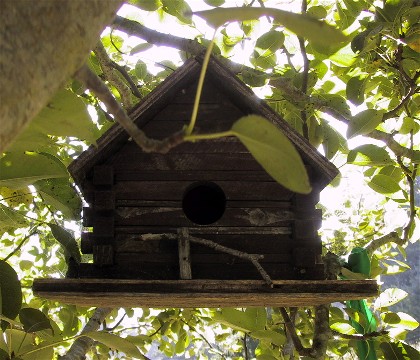
The
Steering Committee met Monday, October 27, 2003 at the Del Mar
Center. Present were Tom Warnock, Mary Austin, John Horn, Jim
Grenwelge, Ben Klagenberg, Dianne Rasmussen, Ralph Rasmussen,
Wink Franklin, MA Brauer, and your faithful scribe, Chester Case.
Jim
Grenwelge reported on preparations for our Annual Harvest Dinner,
which is to be 5:30 pm, Wednesday, November 5, 2003 at the White
Barn, and reviewed which days are to bring what provender. As far
as anyone could recollect, there has been an annual end-
of-the-main-growing-season feast ever since the Garden started.
An email will go to Gardeners to remind them of the particulars.
The Steering Committee will show up at 4:30 to set up and
decorate with the squashes and pumpkins grown this year. Honorary
Gardeners and special guests will be invited for the festivities.
The
unending quest for the successful tomato crops continues. MA
Brauer came upon a “season extender,” a mini-greenhouse
of green, perforated plastic to put over a tomato vine, and
installed some at her home garden where the vines were fine but
the tomatoes wouldn’t ripen. Voilą – good results.
Very little water is used. She proposed an experiment with the
season extender (which basically captures and holds heat around
the vine). The Steering Committee applauded her initiative, and
committed a bed for her experiment next year, which will compare
the effects on the same variety of tomato of the red plastic
mulch (see below), clear plastic, the green plastic
"extender," and regular. MA will select the variety,
propagate seeds, and plant.
Still
pondering the tomato challenge, the Committee considered
the results of the red mulch installed this year. Besides being
the very devil to plant through, the red, plastic sheet teased us
with prolific foilage, bountiful blossoms, a good set of fruit...
but not good ripening.
Tomatoes,
it was observed, have been a persistently problematic crop:
blight, blossom end rot, non-ripening, poor flavor. Over-watering
is highly suspected as a culprit. Or not enough. Or selection of
unhappy varieties. Or both. So MA’s experiment is welcome.
Gardeners will need to observe MA’s procedures and leave the
care of the experimental bed to her.
The
continuing problem of watering was discussed. Too much, too
little, foliage wetted that likes to be dry, erratic. The base
source of the problem appears to lie in uneven watering skills
among the Gardeners, and differences in opinion of when, how
much, and how. Variable weather and quite different needs among
our plants compound the problem. This year’s plan of
assigning certain crops to particular days appeared to reduce the
losses and improve yields. The electronic moisture meter has
worked well.
Dianne
Rasmussen said she will return to the original plan for watering
the flower beds, that is, watering by a designated person with
special training, rather than including the flower beds in the
overall watering chore for the day.
Ben
and the Construction Crew will fall to directly on the Doris Buck
Memorial Trellis. Funds are on hand, the design approved,
materials ordered. Dianne and Ralph Rasmussen announced their
gift of the roses to be planted around the trellis. Anyone
wanting to help build should contact Ben. Remodel of the rusty,
decrepit wire south fence was discussed, the desired outcome
being its accomplishment concurrent with the erection of the
trellis.
The
Committee continued its discussion of the format and content of
an organizational plan. The Committee asked Tom to synthesize the
several versions on hand into a draft plan. The Committee agreed
on the need for some formalization in writing of the Garden’s
organization and practices, and is sensitive to the challenge of
finding a balance between enough and too much structure and
detail. Chester will draft a preamble/mission statement to
preface the next version of the organizational plan.
Wink
Franklin, Treasurer, reported a balance of $3500, which includes
$650 in the Buck Memorial fund. The Garden is finishing the main
growing season in good financial shape.
Tom
will work with TSRA for a Saturday in February, 2004 for the
Organizational Meeting.
Glad
they met in the cool of the Del Mar Center instead of the heat of
the Garden, the Committee adjourned after Tom reported no new
news in negotiations with the Baker Estate.
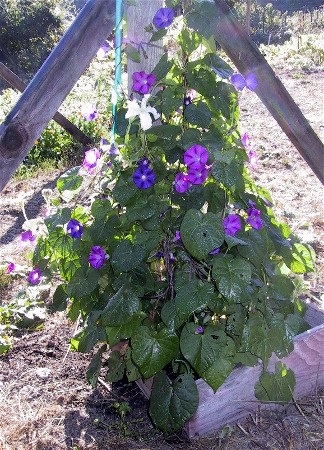
The
Winter Garden is now being planted. Keep your eye on your email
and the Website for how to get involved, and how it will work.
The
Annual Organizational meeting will be in February, 2004. Keep
your eye on the Website and your email for particulars.
|
Seagulls glide Ocean cliffs Stark white dark storm clouds |